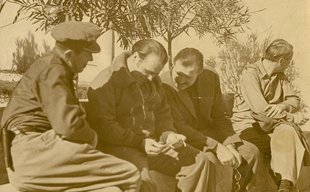Only taking care of animals
The Old Man at the Bridge was originally a report for the North American Newspaper Alliance, NANA. In April 1938, Hemingway was covering the Spanish Civil War in Southern Catalonia. He then included the piece in his collection of short stories, The Fifth Column and the First Forty-Nine. A newspaper article giving background colour was turned into an accessible, simple and profound story
If you type in to Google the title and the author’s surname, you will find the story in full. It’s just two pages. Hemingway is describing the Republican retreat across a pontoon bridge over the River Ebre. Peasants with “mule-drawn carts” are fleeing. Soldiers are helping the men, women and children across the bridge and “up the steep bank.” Hemingway zooms in on an old man, one person in the crowd. The narrator notices him when he crosses the bridge to reconnoitre how close the enemy are and finds him still sitting in the same place when he returns.
“The peasants plodded along in the ankle deep dust,” the enemy is approaching, everyone is escaping, but the old man is immobile. The narrator engages him in conversation, trying to get him to move on. The old man explains that he is 76, has no family and is from San Carlos (Sant Carles de la Ràpita). He’s walked 12 kilometres and can go no further. Individualised by Hemingway’s focus on him, yet he is one more anonymous victim of the war. Being anonymous, the old man stands for all who have been displaced and are, as he says, “without politics”. The narrator knows it is the Fascists who are coming, but his political awareness cannot aid the old man.
The old man is courteous. He is worried about his animals. The cat can look after itself; the doves can fly away; but the two goats are as unlikely to survive as the old man himself. Goats have always been sacrificial victims (scapegoats) and it is not hard to imagine what the occupying forces will do with them. The narrator tries to reassure him with the empty phrases that are all anyone has in such a situation.
It is Easter Sunday, the day of Resurrection, but here it is the day of continuing death. Like the goats, the old man will die. This is perhaps the only false note in the story. Hemingway forces home too much the poignancy of death on the day of Resurrection.
The story concentrates the main themes of Hemingway’s books, that “Life is a bitch,” as he liked to say, and what makes a man admirable is his ability to suffer with “grace under pressure”, especially in the face of death. The old man at the bridge does not complain for himself. He is respected for his courageous acceptance of his fate. His only concern is for his animals.
Limited in scope, The Old Man at the Bridge is a powerful story. Sentimental perhaps, yet Hemingway succeeds in expressing his disgust and anger at the fascist armies.
Good-bye to the Series
This is the 21st and last in this series reviewing English-language novels set in Catalonia. It is not exhaustive. I’ve left out various novels by Patrice Chaplin, whose Albany Park was the pick of 2016. Tibor Fischer’s strange, comic dystopia, Voyage to the End of the Room, set in a sex club in Barcelona’s Raval, or Richard Gwyn’s The Colour of a Dog Running Away should also have been in the series. Nothing against the books, but no room.
It has been an enjoyable series to write. I’ve ended up appreciating books I would not otherwise have looked at: a romantic novel (Jane Mackenzie’s robust Autumn in Catalonia), a forgotten political novel (Ralph Bates’ Lean Men) or a mystical terror story (Jessica Cornwell’s The Serpent Papers). While Girona city was the main theme in last year’s 10 books, this year six out of the 11 have focused on the Spanish Civil War. Jane Mackenzie, Stephen Burgen, Elena Moya and Alex Baron all looked back on the war from later decades, studying its lasting effects on subsequent generations. Ernest Hemingway (featured this month) and Muriel Rukeyser were not looking back, but reported the war directly.
The most amazing background to a book is Rukeyser’s Savage Coast. Her novel was slated in capital letters by her publisher as BAD, in the cruellest way. Only published in 2013, long after her death, it is a subtle, bold novel about a young woman coming to political and personal maturity at the start of the Civil War.
Does reading novels by foreigners help understand Catalonia? Probably not as much as reading novels by Catalans about Catalonia. Some books, like Edna O’Brien’s The High Road, just use the country as an exotic location. Yet often an outsider’s eye may perceive what a native cannot.
My pick as the best this year? Rukeyser’s coming-of-age modernist semi-memoir perhaps, but it is incomplete; James G. Ballard maybe, because he is a great writer, but The Kindness of Women is not the strongest of his books. I was impressed by Stephen Burgen’s and Elena Moya’s powerful and moving novels on the Civil War’s lasting shadow, but for me the prize goes to Richard Manchester.
His Home to Catalonia is a comic novel, with the added value of photos and cartoons about 1990s language teaching in Barcelona. It’s even harder to write a good comic novel than to write a good novel. One reason this one works is that there is a real story about the main character’s fate. Some jokes are awful, but the scenes ring true again and again. Anyone who’s ever had the misfortune to study or teach in a private language academy will recognise the look of desperation on the unkempt, unhealthy-looking teacher’s face as he or she is wondering what the hell to do over the next 50 minutes.




